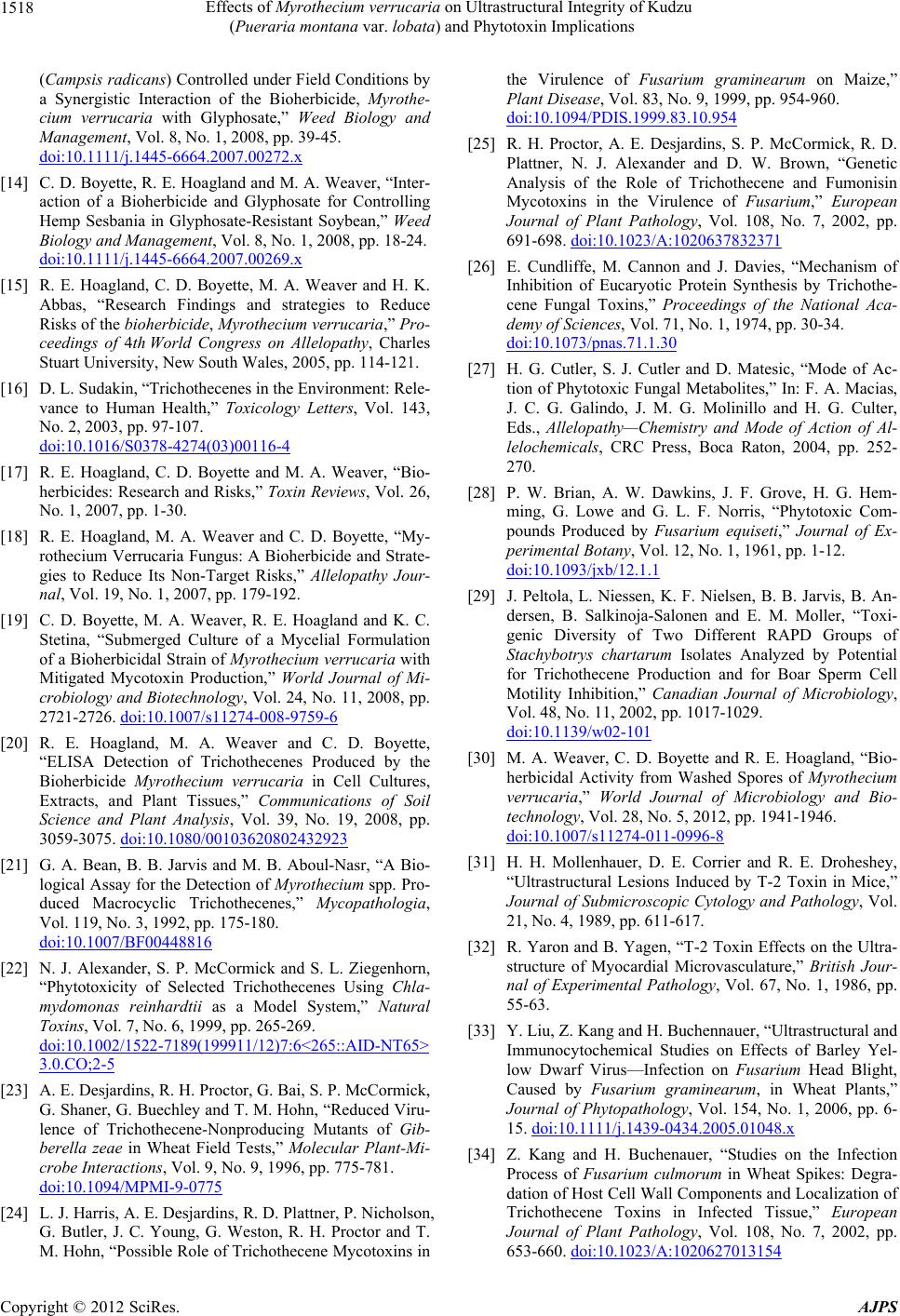
Effects of Myrothecium verru caria on Ultrastructural Integrity of Kudzu
(Pueraria montana var. lobata) and Phytotoxin Implications
1518
(Campsis radicans) Controlled under Field Conditions by
a Synergistic Interaction of the Bioherbicide, Myrothe-
cium verrucaria with Glyphosate,” Weed Biology and
Management, Vol. 8, No. 1, 2008, pp. 39-45.
doi:10.1111/j.1445-6664.2007.00272.x
[14] C. D. Boyette, R. E. Hoagland and M. A. Weaver, “Inter-
action of a Bioherbicide and Glyphosate for Controlling
Hemp Sesbania in Glyphosate-Resistant Soybean,” Weed
Biology and Management, Vol. 8, No. 1, 2008, pp. 18-24.
doi:10.1111/j.1445-6664.2007.00269.x
[15] R. E. Hoagland, C. D. Boyette, M. A. Weaver and H. K.
Abbas, “Research Findings and strategies to Reduce
Risks of the bioherbicide, Myrothecium verrucaria,” Pro-
ceedings of 4th World Congress on Allelopathy, Charles
Stuart University, New South Wales, 2005, pp. 114-121.
[16] D. L. Sudakin, “Trichothecenes in the Environment: Rele-
vance to Human Health,” Toxicology Letters, Vol. 143,
No. 2, 2003, pp. 97-107.
doi:10.1016/S0378-4274(03)00116-4
[17] R. E. Hoagland, C. D. Boyette and M. A. Weaver, “Bio-
herbicides: Research and Risks,” Toxin Reviews, Vol. 26,
No. 1, 2007, pp. 1-30.
[18] R. E. Hoagland, M. A. Weaver and C. D. Boyette, “My-
rothecium Verrucaria Fungus: A Bioherbicide and Strate-
gies to Reduce Its Non-Target Risks,” Allelopathy Jour-
nal, Vol. 19, No. 1, 2007, pp. 179-192.
[19] C. D. Boyette, M. A. Weaver, R. E. Hoagland and K. C.
Stetina, “Submerged Culture of a Mycelial Formulation
of a Bioherbicidal Strain of Myrothecium verrucaria with
Mitigated Mycotoxin Production,” World Journal of Mi-
crobiology and Biotechnology, Vol. 24, No. 11, 2008, pp.
2721-2726. doi:10.1007/s11274-008-9759-6
[20] R. E. Hoagland, M. A. Weaver and C. D. Boyette,
“ELISA Detection of Trichothecenes Produced by the
Bioherbicide Myrothecium verrucaria in Cell Cultures,
Extracts, and Plant Tissues,” Communications of Soil
Science and Plant Analysis, Vol. 39, No. 19, 2008, pp.
3059-3075. doi:10.1080/00103620802432923
[21] G. A. Bean, B. B. Jarvis and M. B. Aboul-Nasr, “A Bio-
logical Assay for the Detection of Myrothecium spp. Pro-
duced Macrocyclic Trichothecenes,” Mycopathologia,
Vol. 119, No. 3, 1992, pp. 175-180.
doi:10.1007/BF00448816
[22] N. J. Alexander, S. P. McCormick and S. L. Ziegenhorn,
“Phytotoxicity of Selected Trichothecenes Using Chla-
mydomonas reinhardtii as a Model System,” Natural
Toxins, Vol. 7, No. 6, 1999, pp. 265-269.
doi:10.1002/1522-7189(199911/12)7:6<265::AID-NT65>
3.0.CO;2-5
[23] A. E. Desjardins, R. H. Proctor, G. Bai, S. P. McCormick,
G. Shaner, G. Buechley and T. M. Hohn, “Reduced Viru-
lence of Trichothecene-Nonproducing Mutants of Gib-
berella zeae in Wheat Field Tests,” Molecular Plant-Mi-
crobe Interactions, Vol. 9, No. 9, 1996, pp. 775-781.
doi:10.1094/MPMI-9-0775
[24] L. J. Harris, A. E. Desjardins, R. D. Plattner, P. Nicholson,
G. Butler, J. C. Young, G. Weston, R. H. Proctor and T.
M. Hohn, “Possible Role of Trichothecene Mycotoxins in
the Virulence of Fusarium graminearum on Maize,”
Plant Disease, Vol. 83, No. 9, 1999, pp. 954-960.
doi:10.1094/PDIS.1999.83.10.954
[25] R. H. Proctor, A. E. Desjardins, S. P. McCormick, R. D.
Plattner, N. J. Alexander and D. W. Brown, “Genetic
Analysis of the Role of Trichothecene and Fumonisin
Mycotoxins in the Virulence of Fusarium,” European
Journal of Plant Pathology, Vol. 108, No. 7, 2002, pp.
691-698. doi:10.1023/A:1020637832371
[26] E. Cundliffe, M. Cannon and J. Davies, “Mechanism of
Inhibition of Eucaryotic Protein Synthesis by Trichothe-
cene Fungal Toxins,” Proceedings of the National Aca-
demy of Sciences, Vol. 71, No. 1, 1974, pp. 30-34.
doi:10.1073/pnas.71.1.30
[27] H. G. Cutler, S. J. Cutler and D. Matesic, “Mode of Ac-
tion of Phytotoxic Fungal Metabolites,” In: F. A. Macias,
J. C. G. Galindo, J. M. G. Molinillo and H. G. Culter,
Eds., Allelopathy—Chemistry and Mode of Action of Al-
lelochemicals, CRC Press, Boca Raton, 2004, pp. 252-
270.
[28] P. W. Brian, A. W. Dawkins, J. F. Grove, H. G. Hem-
ming, G. Lowe and G. L. F. Norris, “Phytotoxic Com-
pounds Produced by Fusarium equiseti,” Journal of Ex-
perimental Botany, Vol. 12, No. 1, 1961, pp. 1-12.
doi:10.1093/jxb/12.1.1
[29] J. Peltola, L. Niessen, K. F. Nielsen, B. B. Jarvis, B. An-
dersen, B. Salkinoja-Salonen and E. M. Moller, “Toxi-
genic Diversity of Two Different RAPD Groups of
Stachybotrys chartarum Isolates Analyzed by Potential
for Trichothecene Production and for Boar Sperm Cell
Motility Inhibition,” Canadian Journal of Microbiology,
Vol. 48, No. 11, 2002, pp. 1017-1029.
doi:10.1139/w02-101
[30] M. A. Weaver, C. D. Boyette and R. E. Hoagland, “Bio-
herbicidal Activity from Washed Spores of Myrothecium
verrucaria,” World Journal of Microbiology and Bio-
technology, Vol. 28, No. 5, 2012, pp. 1941-1946.
doi:10.1007/s11274-011-0996-8
[31] H. H. Mollenhauer, D. E. Corrier and R. E. Droheshey,
“Ultrastructural Lesions Induced by T-2 Toxin in Mice,”
Journal of Submicroscopic Cytology and Pathology, Vol.
21, No. 4, 1989, pp. 611-617.
[32] R. Yaron and B. Yagen, “T-2 Toxin Effects on the Ultra-
structure of Myocardial Microvasculature,” British Jour-
nal of Experimental Pathology, Vol. 67, No. 1, 1986, pp.
55-63.
[33] Y. Liu, Z. Kang and H. Buchennauer, “Ultrastructural and
Immunocytochemical Studies on Effects of Barley Yel-
low Dwarf Virus—Infection on Fusarium Head Blight,
Caused by Fusarium graminearum, in Wheat Plants,”
Journal of Phytopathology, Vol. 154, No. 1, 2006, pp. 6-
15. doi:10.1111/j.1439-0434.2005.01048.x
[34] Z. Kang and H. Buchenauer, “Studies on the Infection
Process of Fusarium culmorum in Wheat Spikes: Degra-
dation of Host Cell Wall Components and Localization of
Trichothecene Toxins in Infected Tissue,” European
Journal of Plant Pathology, Vol. 108, No. 7, 2002, pp.
653-660. doi:10.1023/A:1020627013154
Copyright © 2012 SciRes. AJPS